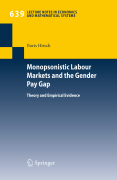
Monopsonistic labour markets and the gender pay gap: theory and empirical evidence
Hirsch, Boris
This book investigates models of spatial and dynamic monopsony and their application to the persistent empirical regularity of the gender pay gap. Theoretically, the main conclusion is that employers possess more monopsony power overtheir female employees if women are less driven by pecuniary considerations in their choice of employers than men. Employers may exploit this to increase their profits at the detriment of women’s wages. Empirically, it is indeed found that women’s labour supply to the firm is less wage-elastic than men’s and that at least a third of the gender pay gap in the data investigated may resultfrom employers engaging in monopsonistic discrimination. Therefore, a monopsonistic approach to gender discrimination in the labour market clearly contributes to the economic understanding of the gender pay gap. It not only provides an intuitively appealing explanation of the gap from standard economic reasoning, but it is also corroborated by empirical observation. INDICE: Introduction.- Part I: Spatial Monopsony: Simple Static Monopsony;Short-Run Spatial Monopsony; Long-Run Spatial Monopsony; Spatial Monopsony and the Gender Pay Gap; Spatial Monopsony and Regional Differences in the GenderPay Gap.- Part II: Dynamic Monopsony: Simple Dynamic Monopsony; A General Equilibrium Model of Dynamic Monopsony; Dynamic Monopsony and the Gender Pay Gap;Concluding Remarks.
- ISBN: 978-3-642-10408-4
- Editorial: Springer
- Encuadernacion: Rústica
- Páginas: 280
- Fecha Publicación: 15/03/2010
- Nº Volúmenes: 1
- Idioma: Inglés
